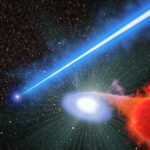NASA’s Chandra X-ray telescope made an incredible discovery in a distant galaxy cluster. This galaxy cluster, known as Zwicky 8338 (Z8338), is located about 670 million light-years from Earth. The Chandra telescope detected two streams of gas crossing each other in this galaxy cluster, creating a fascinating and chaotic scene.
The galaxy cluster Z8338 is a busy place. It is filled with galaxies, superheated gas, and shock waves. These shock waves are like the sonic booms created by supersonic jets. The Chandra telescope captured images showing two new streams of gas trailing behind a galaxy in this cluster. These streams form a huge, comet-like tail of hot gas that stretches over 1.6 million light-years.
This discovery is significant because it helps scientists understand how galaxy clusters evolve. When a galaxy moves through a cluster, it can lose some of its gas. This gas then forms a tail behind the galaxy. In Z8338, the tail of gas split into two streams when it crossed paths with another stream of gas. This crossing of streams can lead to the formation of new stars and planets.
The Chandra telescope’s images show that these streams of gas have crossed each other. This crossing creates a chaotic landscape in the galaxy cluster. The streams of gas are superheated, and their interaction can lead to the creation of new structures within the cluster. This process is important for understanding how galaxies and galaxy clusters change over time.
The Chandra X-ray Observatory is a powerful telescope in the world that studies the universe. It can detect X-rays from hot gas in space. In the case of Z8338, the X-ray data captured by Chandra highlights the pockets of superheated gas within the cluster. These pockets of gas are shown in purple in the images. The images also include optical data from the Dark Energy Survey, which was conducted using the Cerro Tololo Inter-American Observatory in Chile.
The galaxy cluster Z8338 is a fascinating place to study. It is a chaotic mix of galaxies, gas, and shock waves. The Chandra telescope’s discovery of crossing gas streams adds to our understanding of this complex environment. Scientists believe that the interaction of these gas streams can lead to the formation of new stars and planets. This process is important for understanding the evolution of galaxy clusters.
The Chandra telescope’s images show that the streams of gas in Z8338 are not just random. They follow specific paths and interact with each other in interesting ways. The crossing of streams in this galaxy cluster is a key part of its evolution. As the streams of gas interact, they can create new structures within the cluster. These structures can include new stars and planets.
The discovery of crossing gas streams in Z8338 is a major milestone for astronomers. It provides new insights into the behavior of gas in galaxy clusters. The Chandra telescope’s images show that the streams of gas are not just passive. They actively interact with each other, leading to the creation of new structures. This process is important for understanding how galaxy clusters change over time.
The Chandra X-ray Observatory has been a valuable tool for astronomers since its launch in 1999. It has provided detailed images of the universe, helping scientists understand the behavior of hot gas in space. The discovery of crossing gas streams in Z8338 is just one example of the important work being done by the Chandra telescope.
Editor’s Recommendations
- Extraterrestrial Life: SETI Scientist Says ‘We Are Close’ to Finding Aliens
- SpaceX Crew-9 Launches to Retrieve Sunita Williams from ISS
- Annular Solar Eclipse on Oct. 2, Witness the Sky’s Fiery Ring at Breakneck Speed
- Once-in-a-Lifetime Event: Corona Borealis Constellation Shine Brighter as Nova Explosion





